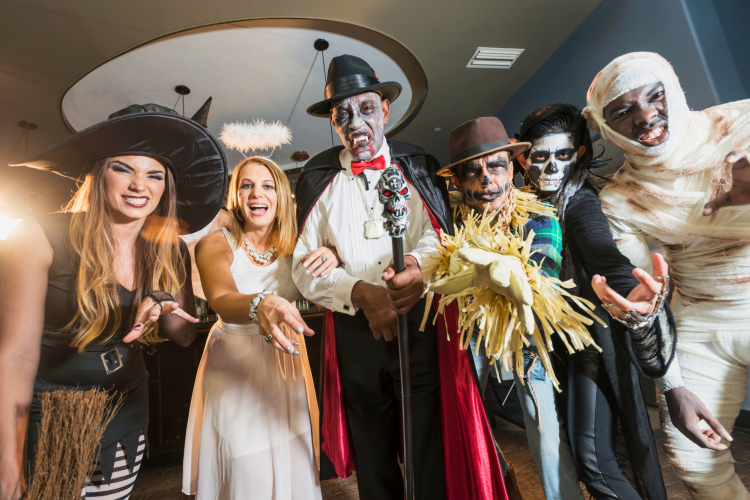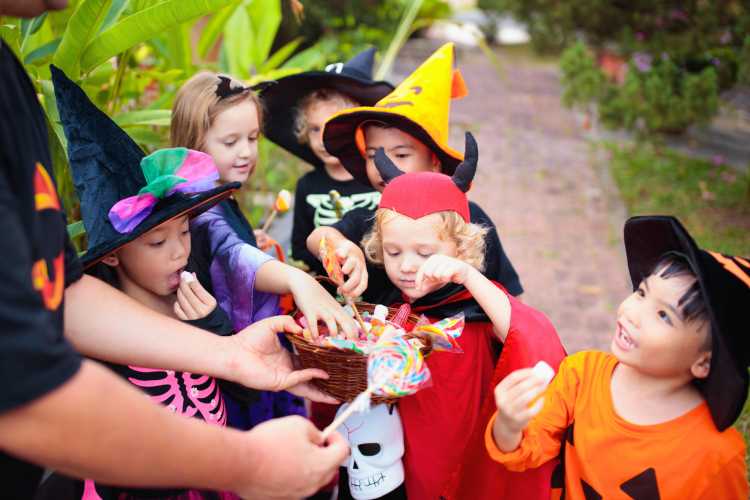What Is Halloween? History to The Haunted Holiday

It’s a holiday that many celebrate, but have you ever wondered, "What is Halloween exactly?", "Why is it celebrated on October 31st?" And "What is its spiritual significance?" We answer these and other questions as we explore Halloween's dark history. Once you get into it, you’ll find it’s a fascinating blend of ancient rituals, folklore and modern traditions. And if you’re looking for on-theme Halloween decoration ideas and creative party themes that honor both its playful and mysterious sides, you’ll find plenty of inspiration based on authentic customs and symbols.
Jump to Section
- What Is Halloween And Why Do We Celebrate It?
- What Is the History of Trick-or-Treating
- What Is the History of Dressing Up On Halloween
What Is Halloween And Why Do We Celebrate It?

When most people think of Halloween, they picture kids trick-or-treating, community parades, typical Halloween colors, bobbing for apples and other fun, family-friendly Halloween activities. But the real story of Halloween’s origins stretches back over 2,000 years to an ancient Celtic festival called Samhain.
What Is The True Story Behind Halloween & Why Is Halloween Celebrated On October 31st?

The story behind the frightening holiday doesn't have to be a Halloween riddle. Let's get right to it. Samhain is a Celtic spiritual tradition which means “summer’s end.” Celebrated from October 31st to November 1st, it marked the end of the harvest season and the start of the dark, cold winter. In Celtic belief, the year was split into two halves — light and dark — and Samhain, being a fire festival, marked the beginning of the dark half. This was a time for rest, reflection and preparation for the challenging months ahead.
For Druids and pagans, Samhain was considered the spiritual new year. It was a time to honor ancestors, reflect on the past and look toward the future. People believed that during this period, the veil between the dead and the living was at its thinnest, making it easier for spirits to cross over. Fairies, sprites and even ghosts were thought to roam the earth during these nights. As a form of protection, people lit large bonfires, offered food to both friendly and mischievous spirits and wore costumes or masks to avoid being recognized by those with harmful intentions.
Halloween history took another turn in the 8th century, when Pope Gregory III proclaimed November 1st as All Saints’ Day, a day dedicated to honoring those of exemplary virtue. Many Samhain traditions, such as wearing costumes, were absorbed into this Christian holiday. The night before was christened All Hallows’ Eve, which later became “Halloween.”
It wasn’t until the mid-1800s, with a wave of Irish immigration to the United States during the potato famine, that Halloween transformed into a popular holiday in North America. Before that, Americans who celebrated it were often inspired by Robert Burns’ 1786 poem Halloween, which included notes on throwing festive gatherings in rural Scotland. Over time, these customs blended with American traditions like pumpkin carving.
Today, Halloween is one of the most celebrated holidays of the year, with an abundance of Halloween quotes we know and love. While its ancient roots are steeped in spiritual and seasonal meaning, modern celebrations focus on fun. Think trick-or-treating, carving jack-o’-lanterns, dressing up and enjoying Halloween candy with friends and family.
Is Halloween Part Of Christianity?
Halloween day actually has its roots in Christian tradition. The name “Halloween” comes from “All Hallows’ Eve,” which is the night before All Saints’ Day — a day dedicated to honoring the goodness and lives of saints. For many Christians, this evening became an opportune time to talk with children about important topics like death, Heaven and Hell. Over time, the customs we now associate with Halloween developed from these reflections and preparations for All Saints’ Day, which is meant to remember and celebrate people who led inspiring and virtuous lives.
What Is The Spiritual Meaning Of Halloween?

At its core, Halloween day is about acknowledging the thin veil between the living and the spirit world. Many of the traditions we associate with the holiday — costumes, masks and lanterns — come from ancient practices meant to protect against, honor or connect with spirits. Today, Halloween still carries this spiritual essence. Dressing up, using symbols and telling stories are ways to reflect on life, death and the mysteries beyond the everyday world. In a way, it’s a reminder of the unseen forces that shape our lives.
What Is the History of Trick-or-Treating

Trick-or-treating is an important part of celebrating Halloween day. The custom involves children traveling door to door, usually in costume. As they travel, they ask neighbors for candy or other kinds of treats. The custom has roots in Ireland and England. During the Middle Ages, a practice called “souling” had the poor visiting homes on All Hallows’ Day (November 1st) to request food. In return, they promised to pray for the souls of the deceased on All Souls’ Day (November 2nd).
By the late 1800s, a similar tradition referred to as “guising” emerged in Scotland, where children disguised themselves in costumes and went door to door for treats. Guising eventually crossed over to the United States in the early 1900s and gradually evolved into what we now call trick-or-treating. The term itself first appeared in the 1920s. By the 1950s, trick-or-treating had become a firmly established part of American Halloween celebrations. Today, over 90% of families hand out candy and millions of kids participate in trick-or-treating and other Halloween festivities.
What Is the History of Dressing Up On Halloween

When you think of Halloween today, you probably picture ghoulish costumes, face paint and candy-filled nights. But if you wondered, "What is Halloween like in its earliest days?" you’d find a very different story. Over 2,000 years ago, people wore costumes to blend in with spirits, using their anonymity to play tricks on friends.
In Scotland, young men called Skeklers dressed in animal skins or straw and went from house to house, singing, dancing and begging for treats in a tradition known as guising. Victorian Halloween added another layer of mystery, with costumes that often drew on eerie motifs like witches, bats and ghosts, reflecting the Victorian obsession with the supernatural. Even so, outfits often mirrored everyday fashion and early 20th-century costumes popularized clowns, devils and classic ghostly figures. Even couples’ Halloween outfits became popular by the mid-20th century, with themes ranging from playful and romantic to dark and spooky.
By the 1930s in America, Halloween masquerades were common community events. People started making costumes months in advance, sparking the holiday’s commercialization. After World War II, as televisions became household staples, a man named Ben Cooper licensed TV favorites like Zorro and Spider-Man for costumes. By the 1960s, Cooper dominated 70 to 80% of the market, and his Spider-Man deal in 1962 marked Marvel’s first-ever merchandising venture. Today’s playful Halloween celebrations and outfits might seem far removed from its early roots, but knowing Halloween's dark history gives the holiday depth.
Halloween's dark history goes back millennia to a time when survival meant living in harmony with the seasons and when the supernatural held sway over the human imagination. What began as a sacred fire festival has transformed through centuries of cultural blending, becoming the playful, candy-filled holiday we know today. From honoring ancestors to warding off malevolent spirits and eventually to trick-or-treating and pumpkin carving, Halloween reflects both our fears and our creativity. It’s a holiday that reminds us of the thin line between the past and the present, the mystical and the everyday.
For even more fun Halloween ideas, check out other experiences happening on Classpop!

